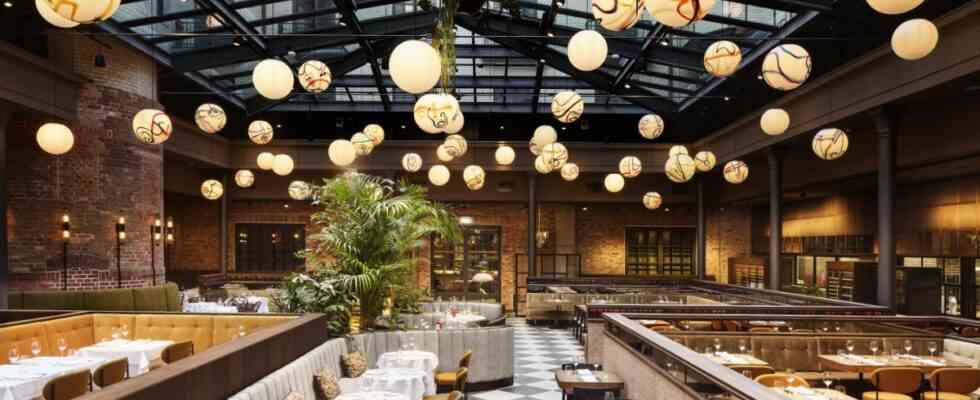You can’t take a step in Berlin without encountering history. This can be depressing because two dictatorships have left their mark on the city. But it can also be exhilarating, because there’s an old building on every corner just begging for a new use. Whether you are standing in front of a WWII bunker, a combined heat and power plant, a brewery or the former headquarters of the GDR transport system – it is almost certain that you will find either an art collection, a club, start-ups or a cluster of studios and rehearsal rooms.
But tourism has grabbed the craziest relics of history. A castle-like Wilhelminian swimming pool in Prenzlauer Berg – today a hotel. The cool Bauhaus-style building that was once the party headquarters of the SED – today a hotel. A brick women’s prison in West Berlin – now a hotel.
The former main telegraph office in Berlin is no exception. A neo-baroque building near the Museum Island, which due to its dimensions could also be a ministry or a district court. At the beginning of the 20th century, this was, so to speak, Germany’s communications center; telegraphs were sent here, long-distance calls were switched or telegrams were accepted. Traces of it can still be found everywhere. In the lobby and in the basement you can see old wooden tables and switch connections, in the hotel rooms there are black dial telephones next to the beds.
400 kilometers of pneumatic tube lines – the internet of the 19th century, so to speak
Above all, however, there are numerous metal pipes labeled with words such as “Annahme” or “Beamtszimmer”. Because Berlin’s pneumatic tube system also ran through here. A total of 400 kilometers long network of pipes, through which cartridges with news were once pushed all over the city with air pressure – the Internet of the 19th and early 20th centuries, so to speak.
The head adds images of people tinkering with devices, or of women from the office mediating conversations, and you immediately feel like watching a few seasons of “Babylon Berlin” about the golden twenties. Which does not mean that this place would not be suitable as a hotel. The first thing you encounter as you walk through the entrance hall with the listed coffered ceiling is a counter with high chairs that stretches almost the entire length of the room – the communication center of the 21st century 1920s is a bar.
This is also due to the operator of the Hotel Telegraphenamt, Roland Mary. The name probably doesn’t mean much to people outside of Berlin at first, but the restaurant that he set up does: the Borchardt. The restaurant in Berlin-Mitte with its red upholstered benches, where politicians, media people, football and film stars eat or party at any time of the day or night, as if there were no tomorrow. Roland Mary is now sitting in jeans and a dark velvet jacket on one of the simple armchairs behind the bar. He’s a bit worn out, the Berlinale with its parties, many of which ended at the Borchardt, is in his bones.
“We just thought it could be good”
Mary has a very Berlin biography. Before becoming a key figure in the capital city scene, he lived in a commune and traveled the world. When asked how he came up with the idea of opening another hotel, he got a very Berlin answer: he just felt like it. “We’re more down-to-earth and don’t sit down and do audience analysis. We just thought it could be good, and then we did it.”
But of course the building also appealed to him. The no-frills construction, the history that goes with it. “You have a different relationship with things that have already been used.” He himself knew the place from Berlin’s wild years. After reunification, the building, which had also served as the central post and telecommunications office in GDR times, was initially used temporarily. Mary remembers a club. Then Telekom moved in and later moved out again. At some point an investor took over the house and it has now been converted into a hotel with around 100 rooms and a few maisonettes.
Industrial charm, minimalist design, and mid-century touches can also be found in the hotel’s rooms.
(Photo: Florian Gröhn)
The minimalist hotel bar has what it takes to become a capital hotspot.
(Photo: Florian Gröhn)
It all happened in this ubiquitous mix of industrial charm, minimalist design and mid-century elements, aimed at an international young audience. This should also feel picked up in the restaurant, where sashimi is served on huge slabs of slate between raw brick walls and a glass ceiling decorated with lantern-like lamps. The hotel is soon to be expanded to include a private club, where expensive paying members can network or do yoga and wellness on 1,200 square meters.
Much in the telegraph office seems overly ambitious, and one misses the relaxed matter-of-factness of an established hotel. But the entrance hall with the old pipes and the minimalist hotel bar has what it takes to become a capital hotspot. Not just because it’s so busy here and you hear countless languages. But because you are in the here and now and at the same time surrounded by the traces of history. It’s a place where the present and the past coincide, which is exactly what Berlin is all about.
Hotel Telegraph OfficeMonbijoustraße 11. Overnight stays in a double room from 213 euros, in a maisonette from 533 euros.

